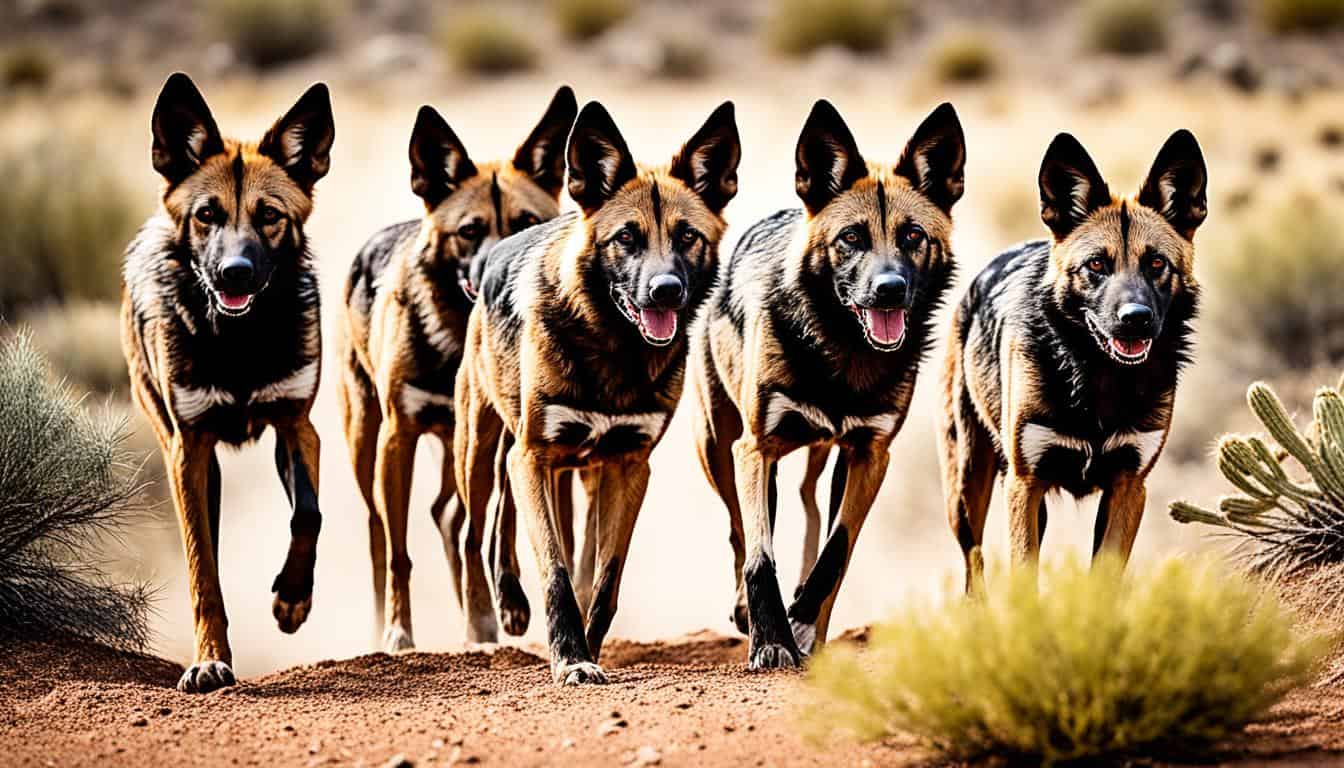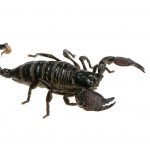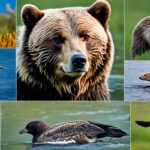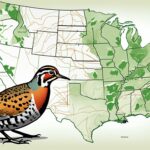Think of wild dogs, and you might picture Australian dingoes or African wild dogs. But, did you know North America has its own wild dog? It’s called the Carolina dog. This breed was found in the 1970s by Dr. I. Lehr Brisbin Jr. They live in the remote southeast of the United States.
Carolina dogs are not like your usual pet dogs. They have unique features that help them survive, like sharp ears and a slim, athletic body. These dogs make us wonder about the many forms nature can take. Are they the distant relatives of the first dogs in North America? Could they have come here with humans thousands of years ago? Discover their incredible story and the rich history of wild dogs in North America.
Introduction to Native Wild Dogs in the USA
North America has a lot of unique wild canine species. Each one has had its own journey in evolution and fills a special ecological role. When you learn about these American wild canids, it’s like taking a peek at the continent’s natural history.
The gray wolf is known for its howl and living in packs. It has fascinated people for a long time. The red wolf is a bit smaller and has a red coat. The way it lives has caused talks about how to protect it. Then there’s the coyote, great at living in many places, from the wild to towns.
The Carolina dog is one of the native wild dogs in the USA. This breed gives us a look into the past when wild canids freely roamed the land. Scientists think they could be from ancient dogs that were around people thousands of years ago. They learned to live in the wild.
Each species helps keep its ecosystem in balance. Their special traits and ways of living show us how they’ve adapted and survived in different places.
You can learn more about these wild canids from a table below. It shows important facts about some American canids. This will help you understand their importance and situation better.
| Species | Scientific Name | Key Characteristics | Conservation Status |
|---|---|---|---|
| Gray Wolf | Canis lupus | Large size, Pack behavior, Howling communication | Least Concern |
| Red Wolf | Canis rufus | Smaller size, Reddish coat, Critically Endangered | Critically Endangered |
| Coyote | Canis latrans | High adaptability, Found in urban areas | Least Concern |
| Carolina Dog | Canis lupus familiaris | Primitive traits, Feral lifestyle | Not evaluated |
Looking deeper into their histories and features will expand your knowledge of these amazing animals. It will show you where they fit in the story of the native wild dogs in the USA.
Overview of American Wild Canid Species
In the USA, there are gray wolves, red wolves, coyotes, and foxes. Each species is vital in its role in nature. By understanding them, we learn more about the importance of biodiversity.
Gray Wolves
Gray wolves have a strong bond within their packs. They come in many varieties across North America. Their teamwork in hunting helps the whole group survive.
Red Wolves
Red wolves are unique with their reddish coats. Once thought to be mixes, they are now a recognized species. Efforts are made to reintroduce them. They may be smaller than gray wolves, but they are key to ecological health.
Coyotes
Coyotes are highly adaptable, living from cities to forests. They can hunt alone or with others, based on what’s around. Their skill in changing hunting methods has helped them thrive across America.
Foxes
Foxes are known for their bushy tails and eat a wide variety of food. These animals live everywhere from deserts to forests. They are important for keeping small animals like rodents in check.
| Species | Distinguishing Feature | Habitat Range |
|---|---|---|
| Gray Wolves | Pack behavior and hunting techniques | Multiple regions across North America |
| Red Wolves | Reddish coat, smaller size | Limited, reintroduced to some areas |
| Coyotes | High adaptability and resourcefulness | Throughout the continent |
| Foxes | Diverse diets, distinctive tails | Various habitats across North America |
Historical Presence of Wild Dogs in North America
The story of wild dogs in North America goes back thousands of years. They first came with humans over the Bering Strait. From there, these dogs spread out. We’ve found their remains all the way from Alaska to the Greater Antilles.
In the 1970s, Dr. I. Lehr Brisbin Jr. rediscovered the Carolina dog. This find is very important in the history of North American wild dogs. The Carolina dog seems to have come from early domestic dogs. It developed special abilities to live in the wild.
“The Carolina dog’s lineage suggests a complex interdependence between humans and dogs, illustrating a fascinating chapter in the historical presence of wild dogs in North America.” — Dr. I. Lehr Brisbin Jr.
The Carolina dog is a great example of survival and change. It shows how people and these dogs have influenced each other. Originally, they lived closely with humans. But they adapted and now they live on their own, showing unique features.
Scientists keep studying the Carolina dog. They want to understand its amazing ability to survive in a changing world. This dog’s story tells us a lot about its strong connection with North America’s past.
| Aspect | Details |
|---|---|
| Migration Path | Bering Strait land bridge to North America |
| Discovery | 1970s by Dr. I. Lehr Brisbin Jr. |
| Significant Locations | From Alaska to the Greater Antilles |
| Unique Traits | Survival and adaptability akin to early domestic dogs |
The Unique Carolina Dog
The Carolina dog is a special type of wild dog in the USA. Fans like to call it the American dingo or Dixie dingo. It was found living freely in far-off places. It shows signs of being like ancient dogs in how it looks and acts.
Its story goes back to ancient times when dogs came to North America with people. The Carolina dog catches the eye of many dog clubs. Even the AKC, a big dog club, has started to pay attention to it through a special program.
This dog is known for its unique tail, ears, and way of having puppies. These things make it stand out from usual pet dogs. They show how well it can live in the wild.
People are working hard to keep the Carolina dog around and make sure others know about it. It’s a key part of wild dog history in the USA. These American dingos are truly remarkable.
Are there any native wild dogs in the USA?
Is there a native wild dog in the USA? The Carolina dog is a key name that comes up. It’s known as a pariah dog. This means they evolved on their own, without much help from humans.
The Carolina dog has a unique story. It differs from domesticated dogs. History and DNA point to them joining early North American settlers. They developed into a unique species over thousands of years.
This dog stands out because they look and act differently. They have alert ears, a slim figure, and are very fit. These traits show they adapted perfectly to living in the wild.
Many wild dogs today have mixed with other breeds a lot. But the Carolina dog’s genes are mostly pure. This shows how a breed can evolve wildly on its own. By studying them, we learn about the past and nature of wild dogs in the USA.
| Feature | Domesticated Dogs | Carolina Dog |
|---|---|---|
| Behavior | Dependent on humans | Independent survival |
| Physical Traits | Varied, bred for specific traits | Alert ears, thin body, athletic build |
| Evolution | Selective breeding by humans | Natural evolution without human intervention |
The Distinction Between Wild and Feral Dogs
It’s key to know the difference between wild and feral dogs, especially about their behavioral traits and domestication. Wild dogs like the Carolina dog live freely without humans. They rely on their natural skills and instincts for survival.

Characteristics of Wild Dogs
Wild dogs, like the Carolina dog, have traits perfect for the wild. They are excellent hunters, work well in packs, and value their territories. These dogs have features like pricked ears and a sleek shape, which help them survive.
Characteristics of Feral Dogs
Feral dogs are those that were once pets but learned to live in the wild again. They show some wild-like survival skills but are usually not as well-adapted as wild dogs. You might see a range of coat colors and textures in feral dogs because of their mixed genes. Yet, their traits still show they came from dogs bred by people.
| Aspect | Wild Dogs | Feral Dogs |
|---|---|---|
| Origins | Born and evolved in the wild | Domesticated ancestors |
| Evolution | Natural selection | Re-adaptation to wild conditions |
| Behavioral Traits | Highly specialized hunting, strong pack dynamics | Variable, often less specialized |
| Physical Characteristics | Streamlined form, erect ears | Genetically mixed, varied appearance |
Physical Characteristics of Carolina Dogs
Carolina dogs’ physical traits show their ability to thrive in the wild. They have a lean and athletic build that helps them move quickly and last long in tough areas. Their long snouts are special, improving their smell and making breathing efficient.
Pointed ears are a key feature of these dogs. These ears stand up, helping them hear better and giving them a ready and watchful look. Carolina dogs come in many coat colors, like reddish ginger and black-and-tan. They often have white marks that make them even more beautiful.
Experts like Dr. I. Lehr Brisbin Jr. give us great insights into these animals. In the table below, you can see the main physical features of Carolina dogs, according to kennel club standards:
| Physical Trait | Description |
|---|---|
| Build | Lean and athletic |
| Snout | Elongated |
| Ears | Pointed and erect |
| Coat Colors | Reddish ginger to black-and-tan, often with white markings |
Behavioral Traits of Carolina Dogs
Carolina dogs’ behavior is truly fascinating. They show how they’ve adapted to live in the wild. Unlike most pet dogs, Carolinas have manners suited for living freely. This includes how they interact, hunt, and grow their families.
Inside their packs, you’ll see organized lives. Hunting together helps them catch more food. It also shows their strong team spirit. Leaders in these packs make sure everyone has a job and a meal.
Hunting and Pack Behavior
When Carolina dogs hunt, it’s a sight to see. They jump on prey or work together to chase it down. This makes them pretty efficient at finding their next meal. It’s a skill that has helped them survive out there.
There’s a boss in Carolina dog packs. This leader calls the shots during hunts. But everyone still gets a turn to eat.
Reproductive Habits
Another cool thing about Carolina dogs is how they grow their families. Females can have babies a few times a year. This happens more than with regular pet dog families. Males stick around to help raise the pups. It’s not something you always see in the wild.
These habits are important for Carolina dog numbers to stay strong. They face a lot of challenges from humans and mixing with pet dogs.
FAQ
Are there any native wild dogs in the USA?
Yes, the USA has a native wild dog, the Carolina dog. Dr. I. Lehr Brisbin Jr. found it in the 1970s. He found them in the wilds of the southeastern United States.
What are American wild canids?
American wild canids are species like gray wolves, red wolves, coyotes, and various foxes. They have a special history and are key to North American ecosystems.
Can you provide an overview of American wild canid species?
– Gray Wolves: They live in packs and are spread across North America.
– Red Wolves: They are smaller and have a unique red coat. Efforts are being made to reintroduce them to the wild.
– Coyotes: They are very adaptable and can be found near people.
– Foxes: Found throughout North America, they have different diets and ways of life.
What is the historical presence of wild dogs in North America?
Wild dogs have been in North America since early humans traveled through the Bering land bridge. The Carolina dog is believed to be linked to these ancient dogs.
What makes the Carolina dog unique?
The Carolina dog stands out from other wild and domestic dogs. It evolved on its own. It has features and behaviors that help it survive in the wild.
How do wild dogs differ from feral dogs?
Wild dogs, like the Carolina dog, are not bred by people. Feral dogs are pets living in the wild again. Wild dogs have evolved to survive in nature better than feral dogs.
What are the physical characteristics of Carolina dogs?
Carolina dogs are slim and fit, with long snouts and pointy ears. They come in colors like reddish ginger and black-and-tan. They often have white markings too.
What are the behavioral traits of Carolina dogs?
Carolina dogs have interesting behaviors. They have a seasonal mating cycle and can mate several times a year. They are skilled hunters, using both pouncing and group hunting.







